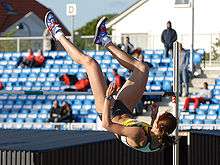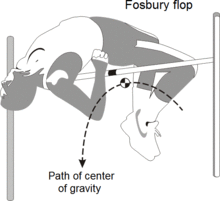Fosbury Flop
The Fosbury Flop is a style used in the athletics event of high jump. It was popularized and perfected by American athlete Dick Fosbury, whose gold medal in the 1968 Summer Olympics brought it to the world's attention.[1] Over the next few years the flop became the dominant style of the event and remains so today. Before Fosbury, most elite jumpers used the straddle technique, Western Roll, Eastern cut-off or even scissors jump to clear the bar. Given that landing surfaces had previously been sandpits or low piles of matting, high jumpers of earlier years had to land on their feet or at least land carefully to prevent injury. With the advent of deep foam matting high jumpers were able to be more adventurous in their landing styles and hence experiment with styles of jumping.
Canadian high jumper Debbie Brill concurrently adopted a similar technique called the "Brill Bend" but Fosbury's Olympic success brought the worldwide fame.


The approach (or run-up) in the Flop style of high jump is characterized by (at least) the final four or five steps being run in a curve, allowing the athlete to lean into his or her turn, away from the bar. This allows the center of gravity to be lowered even before knee flexion, giving a longer time period for the take-off thrust. Additionally, on take-off the sudden move from inward lean to outwards produces a rotation of the jumper's body along the axis of the bar, aiding clearance.
Combined with the rotation around the jumper's vertical axis produced by the drive leg (think of an ice skater spinning round on the spot) the resulting body position on bar clearance is laid out supine with the body at ninety degrees to the bar with the head and shoulders crossing the bar before the trunk and legs. This gives the Flop its characteristic "backwards over the bar" appearance, with the athlete landing on the mat on his shoulders and back.
While in flight the athlete can progressively arch shoulders, back and legs in a rolling motion, keeping as much of the body as possible below the bar. It is possible for the athlete to clear the bar while his or her body's center of gravity remains as much as 20 cm below it.[2]
While the Straddle style required strength in the takeoff knee and could be used by relatively burly athletes (cf. Valeriy Brumel), the Flop allowed athletes of a slender build to use their co-ordination to greater effect and not risk the knee injuries which they had previously suffered from other styles.
Predominantly, athletes using the Flop use a "J" shaped approach, where the first three to five strides head in a straight line at ninety degrees to the bar, with the final four to five being run in a curve as noted above. Some athletes prefer to run all of their strides in a curve; this is known as a "C" shape approach. This was the approach used by Fosbury himself but can lead to errors and inconsistencies in speed, foot placement, angle of approach and body attitude at take-off.
Fosbury himself cleared the bar with his hands by his sides, whereas some athletes cross the bar with their arms held out sidewards or even above their heads, optimising their mass distribution. Studies show that variations in approach, arm technique and other factors can be adjusted to achieve the best performance for each athlete.[3]
For similar reasons noted as drawbacks to the "C" shaped approach, the optimal speed of approach in the Flop is not a full-out sprint. Similarly, increasing the number of strides beyond eight or ten is not recommended unless the athlete has achieved high consistency in the approach and can handle the increased speed. The angle of take-off towards the bar is usually somewhere between fifteen and thirty degrees. The angle must not be too shallow or the jumper jumps too far along the bar, landing on it. If the angle is too wide, there is not enough time to "lay out" in the air.
The "broken" leg (which is thrust into the air first at take-off) is always the nearer leg to the bar. Thus someone who uses a left foot take-off (where the left foot transmits the jump force and is the latter to leave the ground) will approach the bar from its right hand side, curving to his left so that the bar approaches his right shoulder. The right leg will drive into the air and the jumper's body rotates anti-clockwise around the vertical axis to present his back to the bar in flight.
As well as driving the leg and hips at take-off, the athlete should drive or even swing his arms into the air, contributing to the upwards momentum.
References
- ↑ Durso, Joseph (20 October 1968). "Fearless Fosbury Flops to Glory". The New York Times. Retrieved 16 January 2013.
- ↑ Van Pelt, Michael (2005). Space Tourism: Adventures in Earth Orbit and Beyond. Springer. p. 185. ISBN 0-387-40213-6.
- ↑ Biomechanical Analysis of the High Jump
See also
- Debbie Brill, the "Brill Bend"
External links
- Dick Fosbury revolutionised the high jump (from the International Olympic Committee web site)
- Rotation over the bar in the Fosbury Flop analysed & explained by Dr. Jesus Dapena